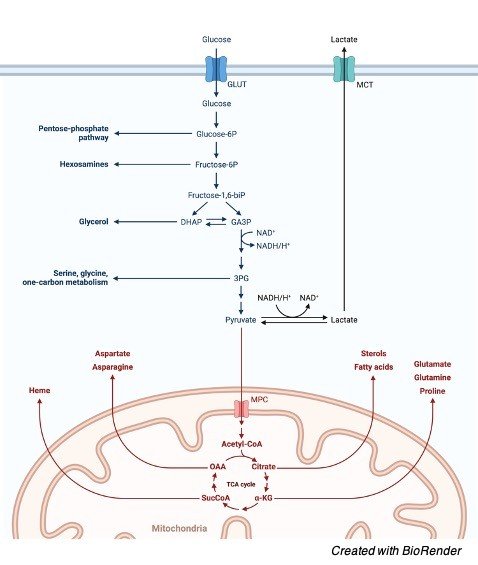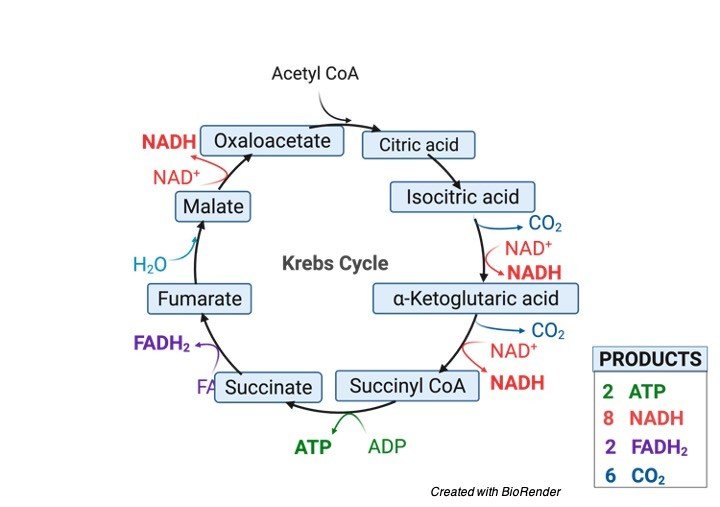What is TCA Cycle?
Tricarboxylic acid cycle, (TCA cycle), also called Krebs cycle and citrus acid cycle, the second stage of cellular respiration, the three-stage measure by which living cells break down organic fuel atoms within the sight of oxygen to harvest the energy they need to develop and isolate.
This metabolic interaction happens in many plants, animals, parasites, and many bacteria.
In all organisms aside from bacteria the TCA cycle is carried out in the matrix of intracellular designs called mitochondria.
History of TCA Cycle
The German British organic chemist Sir Hans Adolf Krebs proposed this cycle, which he called the citrus extract cycle, in 1937. For his work he got the 1953 Nobel Prize in Physiology or Medicine.
Although Krebs elucidated the majority of the reactions in this pathway, there were a few gaps in his plan.
The revelation of coenzyme A in 1945 by Fritz Lipmann and Nathan Kaplan allowed researchers to work out the pattern of reactions as it is known today.
Features of TCA Cycle
The TCA cycle plays a central job in the breakdown, or catabolism, of organic fuel particles—i.e., glucose and some different sugars, fatty acids, and some amino acids.
Before these rather large particles can enter the TCA cycle they should be degraded into a two-carbon compound called acetyl coenzyme A (acetyl CoA).
When taken care of into the TCA cycle, acetyl CoA is changed over into carbon dioxide and energy.

The TCA cycle comprises of eight stages catalyzed by eight distinct proteins. The cycle is initiated;
(1) when acetyl CoA reacts with the compound oxaloacetate to shape citrate and to release coenzyme A (CoA-SH). Then, at that point, in a progression of reactions;
(2) citrate is rearranged to frame isocitrate;
(3) isocitrate loses an atom of carbon dioxide and then, at that point goes through oxidation to shape alpha-ketoglutarate;
(4) alpha-ketoglutarate loses a particle of carbon dioxide and is oxidized to shape succinyl CoA;
(5) succinyl CoA is enzymatically changed over to succinate;
(6) succinate is oxidized to fumarate;
(7) fumarate is hydrated to create malate; and, to end the cycle,
(8) malate is oxidized to oxaloacetate.
Each total turn of the cycle brings about the regeneration of oxaloacetate and the formation of two particles of carbon dioxide.
Why TCA Cycle?
Energy is created in various strides in this pattern of reactions. In sync 5, one particle of adenosine triphosphate (ATP), the atom that powers most cellular capacities, is created.
A large portion of the energy obtained from the TCA cycle, in any case, is captured by the mixtures nicotinamide adenine dinucleotide (NAD+) and flavin adenine dinucleotide (FAD) and changed over later to ATP.
Energy transfers happen through the relay of electrons starting with one substance then onto the next, an interaction carried out through the chemical reactions known as oxidation and decrease, or redox reactions. (Oxidation includes the deficiency of electrons from a substance and decrease the addition of electrons.)
For each turn of the TCA cycle, three particles of NAD+ are diminished to NADH and one atom of FAD is diminished to FADH2.
These atoms then, at that point transfer their energy to the electron transport chain, a pathway that is part of the third stage of cellular respiration.
The electron transport chain thusly releases energy so it tends to be changed over to ATP through the interaction of oxidative phosphorylation.
The TCA Cycle Net Equation
acetyl CoA + 3 NAD + FAD + ADP + HPO4-2 — > 2 CO2 + CoA + 3 NADH+ + FADH+ + ATP
Stage of TCA Cycle
Reaction 1: Formation of Citrate
The principal reaction of the cycle is that the condensation of acetyl-CoA with oxaloacetate to generate citrate, catalysed by citrate synthase.
Whenever oxaloacetate is gotten together with acetyl-CoA, a water particle attacks the acetyl leading to the release of coenzyme A from the complex.

Reaction 2: Formation of Isocitrate
The citrate is rearranged to frame an isomeric structure, isocitrate by a catalyst acontinase. In this reaction, a water atom is taken out from the citric acid and then, at that point set back on in another location. The overall impact of this change is that the – OH bunch is moved from the 3′ to the 4′ situation on the atom. This transformation yields the particle isocitrate.
Reaction 3: Oxidation of Isocitrate to α-Ketoglutarate
In this progression, isocitrate dehydrogenase catalyzes oxidative decarboxylation of isocitrate to frame α-ketoglutarate and NADH forms from NAD. The chemical isocitrate dehydrogenase catalyzes the oxidation of the – OH bunch at the 4′ situation of isocitrate to yield an intermediate which then, at that point has a carbon dioxide atom eliminated from it to yield alpha-ketoglutarate.
Reaction 4: Oxidation of α-Ketoglutarate to Succinyl-CoA
Alpha-ketoglutarate is oxidized, carbon dioxide is eliminated, and coenzyme An is added to shape the 4-carbon compound succinyl-CoA. During this oxidation, NAD+ is decreased to NADH + H+. The compound that catalyzes this reaction is alpha-ketoglutarate dehydrogenase.
Reaction 5: Oxidation of Succinate to Fumarate
Succinate is oxidized to fumarate. During this oxidation, FAD is decreased to FADH2. The compound succinate dehydrogenase catalyzes the removal of two hydrogens from succinate.
Reaction 6: Hydration of Fumarate to Malate
It is speed up by fumarase (fumarate hydratase). Fumarase proceeds with the rearrangement cycle by adding Hydrogen and Oxygen back into the substrate that had been recently taken out.
Reaction 7: Oxidation of Malate to Oxaloacetate
Malate is oxidized to create oxaloacetate, the starting compound of the citric acid cycle by malate dehydrogenase. During this oxidation, NAD+ is decreased to NADH + H+.
Total ATP Generation in TCA Cycle
Total ATP = 12 ATP
3 NAD+ = 9 ATP
1 FAD = 2 ATP
1 ATP = 1 ATP
Investigating the entire interaction, the Krebs cycle primarily transforms the acetyl gathering and water, into carbon dioxide and empowered types of different reactants.
Significance of TCA Cycle
Intermediate mixtures framed during TCA cycle are utilized for the blend of biomolecules like amino acids, nucleotides, chlorophyll, cytochromes and fats and so forth.
Intermediate like succinyl CoA takes part in the formation of chlorophyll.
Amino Acids are shaped from α-Ketoglutaric acid, pyruvic acids and oxaloacetic acid.
TCA cycle (citric Acid cycle) releases a lot of energy (ATP) needed for various metabolic activities of cell. By this cycle, carbon skeleton are got, which are utilized in interaction of development and for maintaining the cells.
TCA Cycle Citations
- Mitochondrial TCA cycle metabolites control physiology and disease. Nat Commun . 2020 Jan 3;11(1):102.
- The TCA cycle as a bridge between oncometabolism and DNA transactions in cancer. Semin Cancer Biol . 2017 Dec;47:50-56.
- Citric acid cycle and role of its intermediates in metabolism. Cell Biochem Biophys . 2014 Apr;68(3):475-8.
- The emerging role and targetability of the TCA cycle in cancer metabolism. Protein Cell . 2018 Feb;9(2):216-237.
- Respiratory metabolism: glycolysis, the TCA cycle and mitochondrial electron transport. Curr Opin Plant Biol . 2004 Jun;7(3):254-61.
Share









